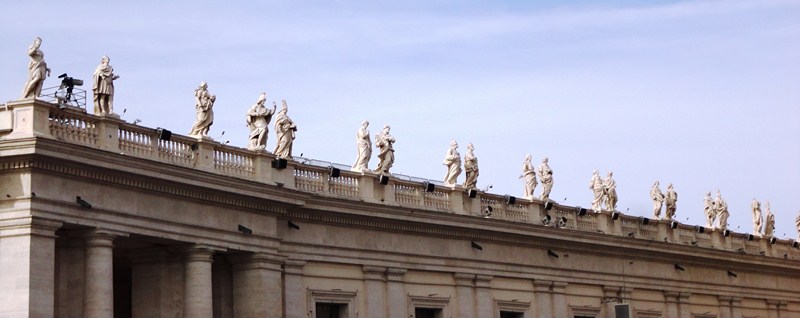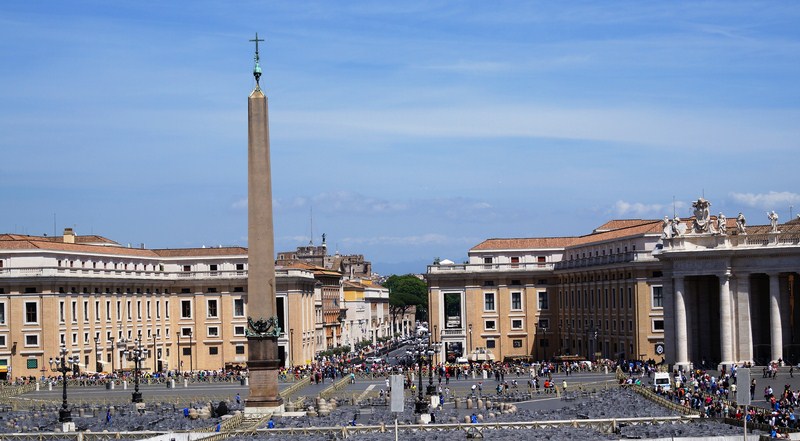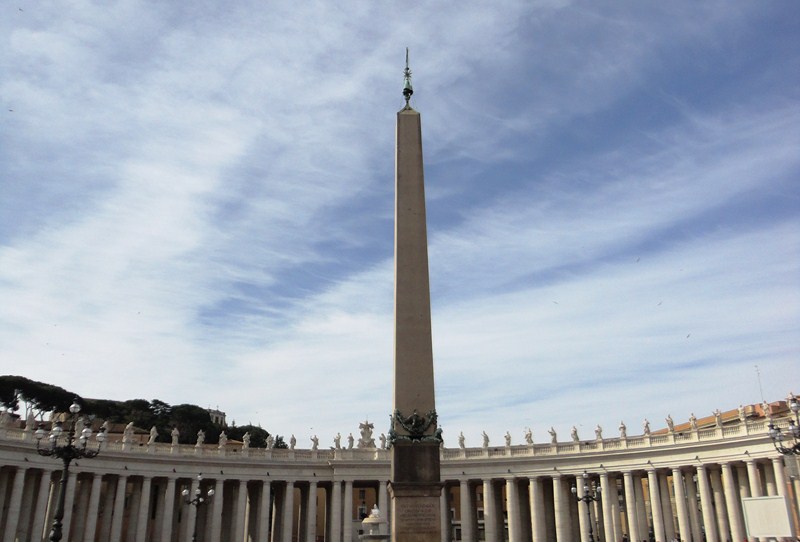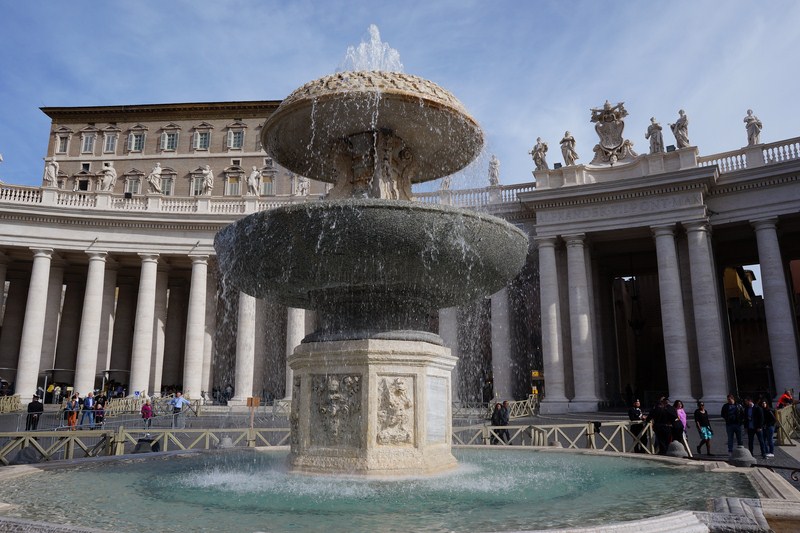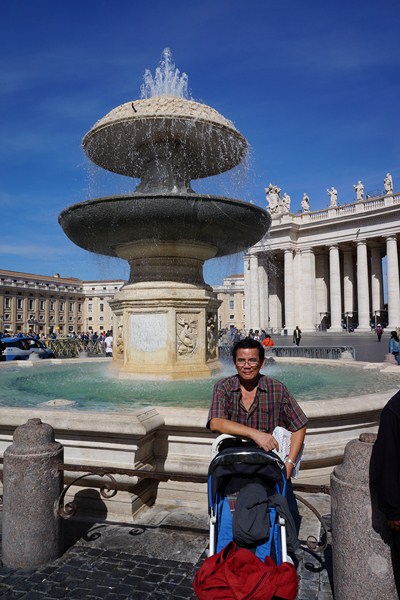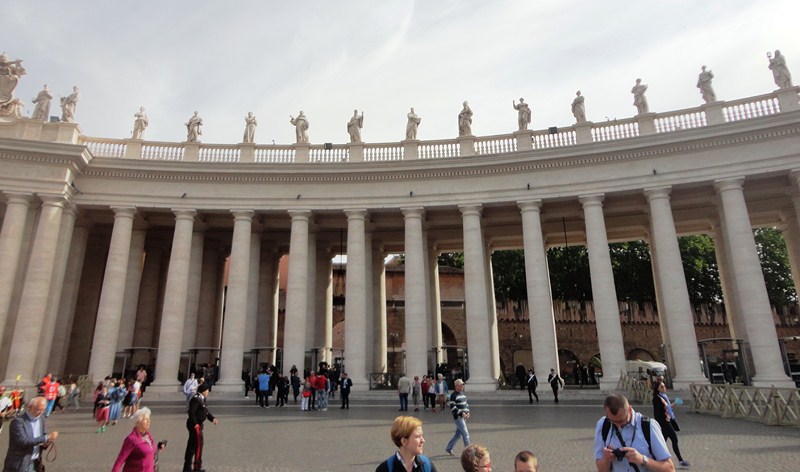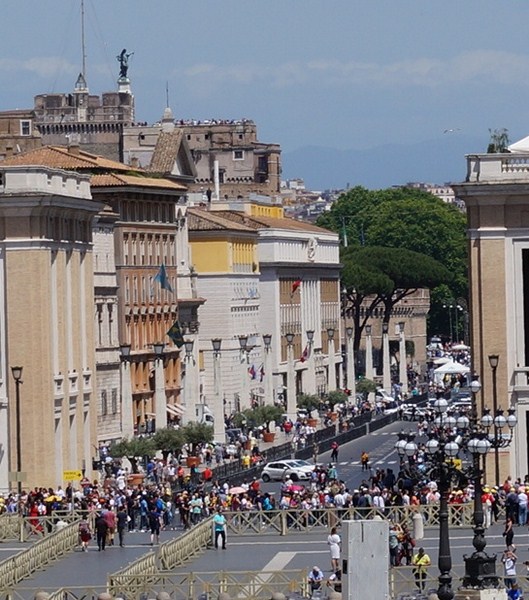To the east of the basilica is the Piazza di San Pietro (St. Peter’s Square), a forecourt in two sections – the first is oval and the second, nearest the basilica, is trapezoid., The two distinct areas are framed by tall colonnades formed by doubled pairs of columns supporting an entablature of the simple Tuscan Order.
The present arrangement, the Baroque inspiration of Bernini, was constructed between 1656 and 1667. The colonnades consist of 284 13 m. high Doric columns, arranged in four rows, and 88 pilasters of travertine marble. With the trabeation surmounted by a balustrade, the overall height is 21 m.
The colonnade, on the north side, masks an assortment of Vatican structures. Above it rises the upper stories of the Vatican Palace. On the south side, they define and formalize the space, with the Barberini Gardens rising to a skyline of umbrella pines.To link with the basilica’s façade, Bernini built two straight 120 m. long covered wings (Charlemagne on the left, Constantine on the right).
A centrally placed ancient Egyptian obelisk, known as “The Witness,” is revered as a “witness” to Peter’s death by crucifixion, with head downwards, on October 13, 64 AD during the reign of the Roman Emperor Nero. Here are some trivia regarding the obelisk:
- It is the second largest standing obelisk.
- It is the only one to remain standing since its removal from Egypt and re-erection at the Circus of Nero in 37 AD.
- It has a height of 25.5 m. (84 ft.).
- If its base and the cross on top are include, it has a total height of 40 m. (130 ft.).
- Its removal to its present location September 28, 1586, by order of Pope Sixtus V, was engineered by Domenico Fontana in a difficult operation that nearly ended in disaster. During the operation, the ropes holding the obelisk began to smoke from the friction. Fortunately, this problem was noticed by Benedetto Bresca, a sailor of Sanremo, who swiftly intervened. As a reward, his town was granted the privilege of providing the palms that are used at the basilica each Palm Sunday.
To ornament the square in front of St. Peter’s Basilica, two fountains were created by Carlo Maderno (1612–1614), the nephew of the architect Domenico Fontana, and Gian Lorenzo Bernini (1667–1677. The fountains, like all fountains of the time, had no pumps and operated purely by gravity, with its source of water, the restored Acqua Paola (on the Janiculum hill, 266 m. above sea level) higher than the fountain which caused the water to shoot 20 ft. upwards into the air.
The older fountain, by Maderno, on the north side of the square, is located on the site of an earlier fountain (reputed to be the finest fountain in Rome), built in 1490 during the time of Pope Innocent VIII. The new fountain had an octagonal base on top with a large irregular basin, decorated with steps and small columns, to hold the water. Maderno kept the the old fountain’s large lower stone vasque and ornamented the pedestal above it with four stone scrolls.
However, the smaller upper vasque was removed and replaced it with an inverted vasque or cap like a mushroom and covered with stone scales. From the top, water spouted poured down over the top of the upper vasque, its flow broken and made to sparkle by the stone scales. Maderno also removed the coats-of-arms of the 3 previous popes (including the 3 coats-of-arms of Pope Innocent VIII, carved by Alonso du Capua), replacing them with plaques honoring his patron, Pope Paul V.
The second, 8 m. high fountain, on the left, was built for purposes of symmetry. It closely followed the design of the Maderno fountain and was built by Gian Lorenzo Bernini who was commissioned in 1667 by Pope Clement X. The fountain was completed in 1677.
The long and wide Via della Conciliazione, built by Mussolini after the conclusion of the Lateran Treaties, leads from the River Tiber to the piazza. It gives distant views of St. Peter’s as the visitor approaches.


